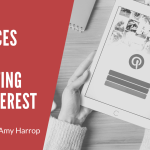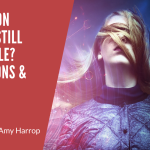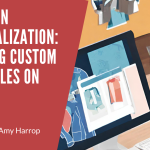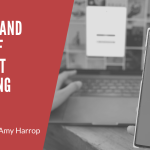Marketing printable and POD products on Pinterest is something that can help you connect with your audience and grow your online business. But wouldn’t it be great if there were an easy way to create more personalized content for segments of your audience without spending a ton of time or money?
is something that can help you connect with your audience and grow your online business. But wouldn’t it be great if there were an easy way to create more personalized content for segments of your audience without spending a ton of time or money?
Pinterest’s new dynamic creative ads are helping users to do exactly that. They allow users to customize content and increase engagement. Here’s what you need to know.
What Are Pinterest’s Dynamic Creative Ads?
Dynamic creative ads allow users to create multiple versions of the same Pin with content – including product descriptions and prices – designed to appeal to specified segments of their followers.
These ads can pull content from your digital assets or from your product feed. Considering that Pinterest has reported an 85% increase in users engaged in shopping activities between March 30 and September 30 of 2020, it makes sense that they would want to provide tools for marketers that will allow them to capitalize on the trend.
The best part about dynamic creative ads is that they are personalized automatically using real-time audience data. That makes them far less time-consuming to create than targeted ads that you might create from scratch. According to Pinterest the new ad format:
… reduces the time and effort required to make custom ads that are relevant to unique groups of customers, but helps advertisers test and identify which creative elements drive performance.
Said another way, dynamic creative ads allow you to use data to increase your sales and test creative elements of advertising at the same time.
How Do Dynamic Creative Ads Work?
To create a Pinterest dynamic creative ad, you’ll need to choose one of the three advertising platforms that have partnered with Pinterest to create the ads. They include StitcherAds, RevJet, and Smartly.io, all of which offer optimization services for social media advertising.
All three services allow you to upload digital images or choose images from your product feed to feature in the ads. The images are then combined with real-time audience data courtesy of Pinterest with the idea that the data used will ensure that your ads will appear when Pinterest users search for products like yours – and that they’ll display in a format that the algorithm determines will be most appealing to the person who is seeing it.
How Do Dynamic Creative Ads Perform?
There’s not a lot of data available about Pinterest’s dynamic creative ads because they are still relatively new. However, StitcherAds listed some results in a recent blog post, and they’re promising.
- An average increase of 11% in return on ad spending (ROAS)
- An average increase of 55% in the conversion rate
- An average decrease of 7% in cost per purchase
These numbers show that it is reasonable to expect more sales and a higher profit on each sale thanks to the reduction in cost per purchase. There’s no denying that the possibilities are exciting.
How to Create Dynamic Creative Ads
While you have your choice of which Pinterest partner to use to create your dynamic creative ads, the general process for all three is basically the same.
- You’ll need to decide ahead of time which products you want to advertise and which images you would like to use in your ads.
- You’ll choose a Pinterest template (all three partners provide them) to use for your ads.
- You’ll specify which static information you want to display. Examples might include:
- Your company logo
- Your company fonts
- Your company colors
- You’ll provide analytics from both Pinterest and your website to help with personalization.
- You’ll specify your ad spending requirements.
Once you have used the template to create your ad, the rest of what happens is automated. Using the metrics and product information you have provided the ad partner will create personalized ads governed by the behavior of the people in your target audience. The result is an array of targeted ads designed to ensure that your audience sees ads featuring your products together with the information and presentation that will entice them to buy from you.
Keep in mind that every aspect of your dynamic creative ads on Pinterest can be updated as needed. As you review your results, you may find that you need to re-focus your audience or change out images or products that aren’t getting the response you want.
Tips for Getting the Most from Pinterest’s Dynamic Creative Ads
Now that you know what dynamic creative ads are and the basic steps for creating them, let’s review some tips and best practices to help you make the most of the ads you create.
- Keep the overall look of your dynamic creative ads consistent by using the same logo, fonts, overlays, and other static visual elements on every ad.
- Make sure all images used in your ads are clear and have the correct resolution for Pinterest. The Pinterest guidelines specify a 9:16 aspect ratio. You can find complete image guidelines here.
- Create hyper-personalized ads based on city, zip code, weather, and store coordinates.
- Create ads in multiple languages if you have target audiences that are not located in the United States.
- Advertise multiple products within a single Pin to get the most for your advertising dollar.
- Review your ad performance regularly and adjust as needed. The performance of dynamic creative ads can do a lot to help you fine-tune your marketing and advertising and maximize the return on your advertising investment.
As is the case with any other type of social media advertising, you should plan on keeping an eye on your ad metrics and performance as your ads roll out. It’s easy to tweak ads if you’re not getting the results you want.
Pinterest’s new dynamic creative ads offer online publishers and entrepreneurs an affordable and effective way to market their products to Pinterest users.
Do you need help growing your online business? Click here to work with me!



